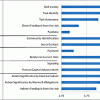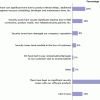Strategic advice to leverage new technologies
Technology is at the heart of nearly every enterprise, enabling new business models and strategies, and serving as the catalyst to industry convergence. Leveraging the right technology can improve business outcomes, providing intelligence and insights that help you make more informed and accurate decisions. From finding patterns in data through data science, to curating relevant insights with data analytics, to the predictive abilities and innumerable applications of AI, to solving challenging business problems with ML, NLP, and knowledge graphs, technology has brought decision-making to a more intelligent level. Keep pace with the technology trends, opportunities, applications, and real-world use cases that will move your organization closer to its transformation and business goals.
Recently Published
As architects, we are constantly challenged to provide value to the business. Much of the value we provide comes from avoiding costs and problems before they occur and is difficult to demonstrate or quantify. But architecture can also deliver value by providing a better, broader, more flexible, and extensible solution to business requirements. I always look for opportunities or projects where an architectural approach will provide a better solution and try to seize these chances when I can.
A 1983 New Yorker cartoon shows a man taking his son on a walk. "It's good to know about trees," he says to the boy, then adds almost as an afterthought, "Just remember, nobody ever made big money knowing about trees."1 Self-motivation is a well-established explanation for why people get involved.
The Value of Social
Agile and lean adoptions don't always work. This Advisor shares a few examples of lean and agile adoptions that failed to make things better. These types of agile adoptions are more common than we would like to think. If you are experiencing any of these failure states, you are not alone. But remember that you do not have to accept results like these; they can be fixed. Let's examine four of these failure states more closely.
Secure Software: Part II -- Hackers and Cyber Attackers
Cloud Strategy: Some Good Tactics to Implement
It appears lately that all business consulting has something to do with cloud computing. For instance, an organization I am currently working with has a mandate in place requiring all forward-engineering projects to be developed using a virtualized cloud environment. This effort is, in this organization's "corporate mind's eye," a way to prepare it to move production applications into the cloud, which is something it has not previously done.
Today's unprecedented growth rate of data (structured and unstructured) necessitates faster and cost-effective processing for near-real-time decision making. Over the years, many have viewed high-performance computing (HPC) as a monster too complex and too unaffordable for processing large data. However, that viewpoint is changing rapidly due to open source innovations such as Apache Hadoop, the advent of the cloud, and simple and affordable platforms like Microsoft.
"Big Data" was one of the hottest IT buzzwords of 2011, and you can expect the hype only to increase this year. BI vendors, the IT press, and analytics gurus go on and on about the need for organizations to meet their Big Data requirements. All the excitement around Big Data is not just hype, however. Today we are seeing organizations develop some very impressive applications that were impractical, if not impossible, just a few years ago.










